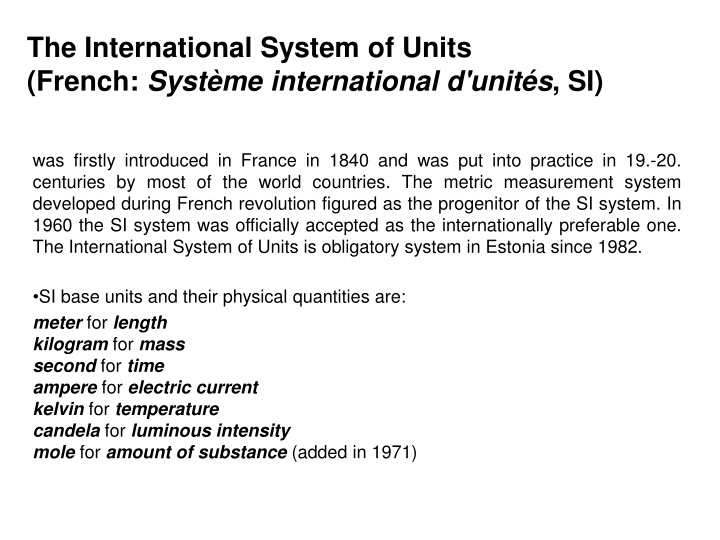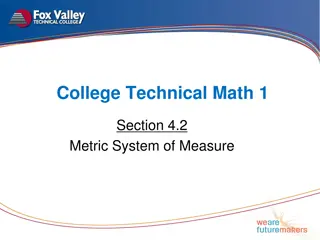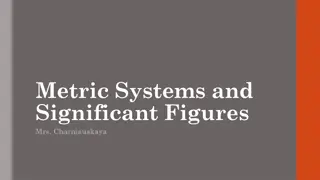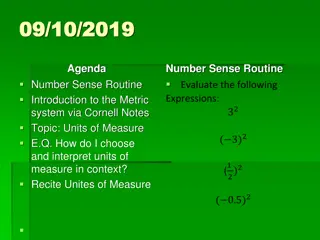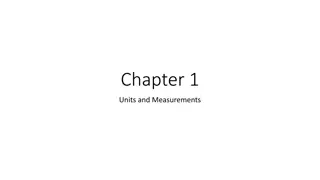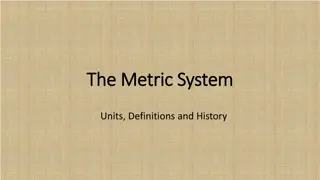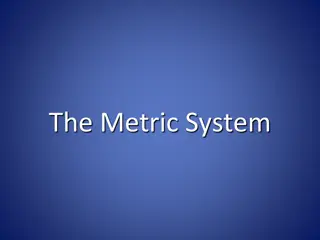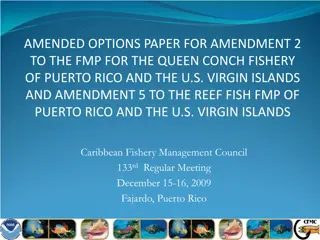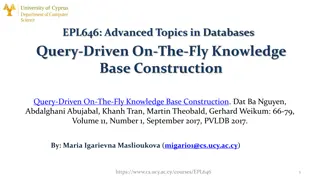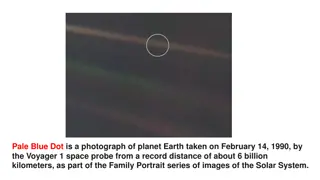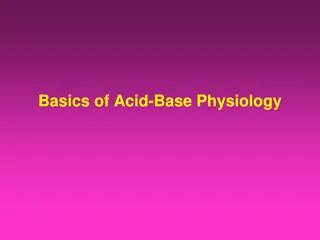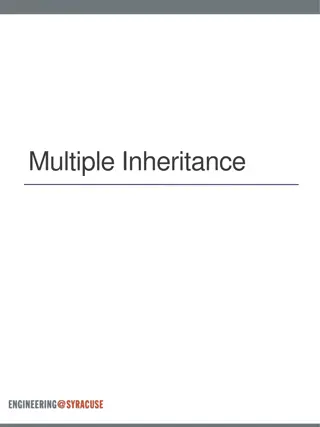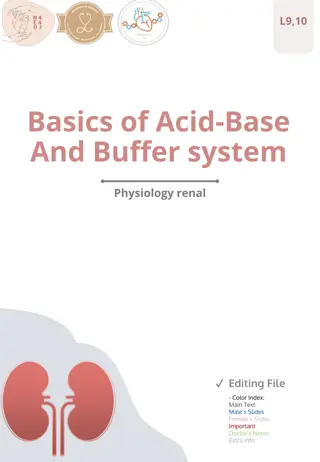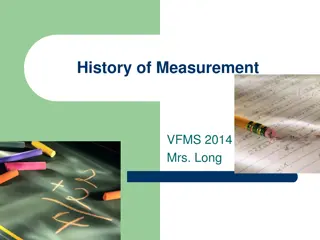Evolution of the International System of Units (SI) and Its Base Units
The International System of Units (SI) was introduced in France in 1840 and became globally accepted by the mid-20th century. SI is mandatory in Estonia since 1982, with base units including meter, kilogram, second, ampere, kelvin, candela, and mole. Each base unit is defined by specific physical constants or properties, such as the speed of light for the meter or the mass of a prototype for the kilogram. The development and definitions of these units have evolved over time through international agreements and scientific advancements.
Download Presentation

Please find below an Image/Link to download the presentation.
The content on the website is provided AS IS for your information and personal use only. It may not be sold, licensed, or shared on other websites without obtaining consent from the author.If you encounter any issues during the download, it is possible that the publisher has removed the file from their server.
You are allowed to download the files provided on this website for personal or commercial use, subject to the condition that they are used lawfully. All files are the property of their respective owners.
The content on the website is provided AS IS for your information and personal use only. It may not be sold, licensed, or shared on other websites without obtaining consent from the author.
E N D
Presentation Transcript
The International System of Units (French: Syst me international d'unit s, SI) was firstly introduced in France in 1840 and was put into practice in 19.-20. centuries by most of the world countries. The metric measurement system developed during French revolution figured as the progenitor of the SI system. In 1960 the SI system was officially accepted as the internationally preferable one. The International System of Units is obligatory system in Estonia since 1982. SI base units and their physical quantities are: meter for length kilogram for mass second for time ampere for electric current kelvin for temperature candela for luminous intensity mole for amount of substance (added in 1971)
SI base units Current (2005) formal definition Historical origin / justification Dimension symbol Name Symbol Measure "The metre is the length of the path travelled by light in vacuum during a time interval of 1 299792458 of a second." 17th CGPM (1983, Resolution 1, CR, 97) 1 10,000,000 of the distance from the Earth's equator to the North Pole measured on the circumference through Paris. metre m length L "The kilogram is the unit of mass; it is equal to the mass of the international prototype of the kilogram." 3rd CGPM (1901, CR, 70) The mass of one litre of water. A litre is one thousandth of a cubic metre. kilogram kg mass M
"The second is the duration of 9192631770 periods of the radiation corresponding to the transition between the two hyperfine levels of the ground state of the caesium 133 atom." 13th CGPM (1967/68, Resolution 1; CR, 103) "This definition refers to a caesium atom at rest at a temperature of 0 K." (Added by CIPM in 1997) The day is divided in 24 hours, each hour divided in 60 minutes, each minute divided in 60 seconds. A second is 1 (24 60 60) of the day. second s time T The original "International Ampere" was defined electrochemically as the current required to deposit 1.118 milligrams of silver per second from a solution of silver nitrate. Compared to the SI ampere, the difference is 0.015%. "The ampere is that constant current which, if maintained in two straight parallel conductors of infinite length, of negligible circular cross-section, and placed 1 metre apart in vacuum, would produce between these conductors a force equal to 2 10 7 newton per metre of length." 9th CGPM (1948) electric current ampere A I
"The kelvin, unit of thermodynamic temperature, is the fraction 1 273.16 of the thermodynamic temperature of the triple point of water." 13th CGPM (1967/68, Resolution 4; CR, 104) "This definition refers to water having the isotopic composition defined exactly by the following amount of substance ratios: 0.000 155 76 mole of 2H per mole of 1H, 0.000 379 9 mole of 17O per mole of 16O, and 0.002 005 2 mole of 18O per mole of 16O." (Added by CIPM in 2005) "1. The mole is the amount of substance of a system which contains as many elementary entities as there are atoms in 0.012 kilogram of carbon 12; its symbol is 'mol.' 2. When the mole is used, the elementary entities must be specified and may be atoms, molecules, ions, electrons, other particles, or specified groups of such particles." 14th CGPM (1971, Resolution 3; CR, 78) "In this definition, it is understood that unbound atoms of carbon 12, at rest and in their ground state, are referred to." (Added by CIPM in 1980) The Celsius scale: the Kelvin scale uses the degree Celsius for its unit increment, but is a thermodynamic scale (0 K is absolute zero). thermodynamic temperature kelvin K Atomic weight or molecular weight divided by the molar mass constant, 1 g/mol. amount of substance mole mol N
"The candela is the luminous intensity, in a given direction, of a source that emits monochromatic radiation of frequency 540 1012hertz and that has a radiant intensity in that direction of 1/683 watt per steradian." 16th CGPM (1979, Resolution 3; CR, 100) The candlepower, which is based on the light emitted from a burning candle of standard properties. luminous intensity candela cd J
Decimal prefixes SI is the decimal unit system what means that all original unit multiples are integer powers of ten and decimal prefixes are used to show greater or smaller amount of original unit (multiplication or division by 10 in some power). For example, kilo- denotes a multiple of a thousand and milli- denotes a multiple of a thousandth, so there are one thousand millimetres to the metre and one thousand metres to the kilometre. The prefixes are never combined, so for example a millionth of a metre is a micrometre, not a millimillimetre. Multiples of the kilogram are named as if the gram were the base unit, so a millionth of a kilogram is a milligram, not a microkilogram.
Underestimating the units can be REALLY EXPENSIVE! In 1998 NASA lost its satellite Mars Climate Explorer that costed 125 million dollars. The reason was that Lockheed- Martin used Imperial unit system when NASA used SI system. The difference between the kilometres and miles was fatal since satellite should stay on the 140 km orbit but went down to 57 km and burned in the atmosphere.
The kWh is the unit of energy, not the unit of power! On all electrical devices you can see the number showing the amount of power these devices require. For example: Mixer 500W PC up to 400W cooking oven 2000W = 2 kW iron 500 to 2000W microwave oven 800W Watt (W) as well as kilowatt (kW) is a unit of power. However, the kilowatt hour (kWh) is an energy unit. It shows how much energy the device consumes or produces if it requires power of 1W and works for 1 hour. 1 kWh = 1000 Js-1 3600 s = 3.6 106 J If you cook a meat for 1.5 hour in 2 kW oven, then during that time you consumed 2 kW 1.5 h = 3 kWh 11 106J of energy.
In the last month you consumed energy of 500 kWh. How many J were consumed and how much will it cost if for 1 kWh you should pay 4.97+5.53+0.87+0.447 eurocents? W=J s-1 1 kWh = 103J s-1 3600s = 3.6 106J 1 kWh-> 11.82 eurocents/kWh 500 kWh 0.1182 /kWh = 59.1 (+tax) 500 3.6 106= 1.8 109J = 1.8 GJ
Ampere-hour unit (Ah) Ampere-hour unit is neither energy or power unit but it is the unit of electric charge, commonly called battery capacity. According to the definition of the electrical current, the product of current and time is the charge. Battery capacity of 1 Ah means that the battery secures current of 1 A for 1 hour. The capacity in Ah is marked on the batteries and accumulators of all mobile telephones, smartphones, laptops and car accumulators.
The units of pressure SI unit pascal: 1 Pa = 1 N/m2 Unit bar: 1 b = 105 N/m2= 750.08 mm Hg 1 mb (millibar) = 10-3b = 100 Pa = 1 hPa 1 millibar = 1 hectopascal 760 mm Hg = 1013.2 mb = 1 atm = 1.013 105 Pa An unit used in the engineering: technical atmosphere (1 at) 1 at = 1 kG /cm2= 9.81 104Pa 1 mm Hg = 1 Torr = 13.595 mmH2O In the British Imperial System of units the unit pound per square inch (psi) is also used. 1 psi = 6.895 kPa 220px-Libr0367 Evangelista Torricelli
Sound pressure Sound pressure is the pressure that appears when sound propagates in the gas or liquid environment. This is the pressure to the area caused by acoustical oscillations. The smallest pressure that average human being can feel/sence with his ear is 10-5Pa. This is 1010times smaller than the pressure of the earth atmosphere. From pressure of 100 Pa we start to feel the pain (1 atm=105 Pa) Sound pressure or noise level is relative sound pressure that is defined in decibells (dB) basing on minimal sound level that humans can hear. This level is p0= 2*10-5 N/m2= 20 Pa. Relative sound pressure is noted as Lpand defined as Not all scales are linear!
The difference of potential of between two points within an electrical field is one volt (1V) if there is required one Joul (1J) of work to move the charge of 1 coulomb (1C) from 1 point to another. 1 J = 1C 1V To move one electron from one point to another we need to conduct a work worth of 1 electronvolt. 1 eV = 1. 6021 10-19 C 1V The electronvolt is as smaller than 1 J as electron charge is smaller than 1 C. 1 eV = 1. 6021 10-19J Culon (C) is the unit of electrical charge in the SI system. It is equal to electrical charge tha passes conductor crossection area during 1 s if the electrical current is 1 A. 1 C is also equal to such charge that is stored inside the electrical capacitor which capacity is 1 F and the difference of the potentials is 1 V. 1 C = 6 241 509 629 152 650 000 of elementary charges.
Conversion of units https://en.wikipedia.org/wiki/Conversion_of_units http://www.unit-conversion.info/ https://www.cs.utexas.edu/users/novak/units95.html
mistakes 1 M = .. . nM 1 m = 10-6m 1m = 106 m 1 nm = 10-9m 1m = 109nm 1 M = 10-6M 10+9nM = 103nM > n, difference 103times -> 1 M = 10+3nM 5 m min -1=............. ........ cm h-1 5 m min-1= 5 102cm / (1/60) h = = 5 102cm 60 / h = 3 10 4 cm / h 1h = 60 min 1 min = 1/60 h
200 Pa = .. N mm-2 Pa = N m -2 200 Pa = 200 N/m 2= 200 N / 10 6 mm 2 = 2 10 -4N mm -2 1m = 103 mm (1m)2= (103 mm)2 1m2= 106 mm2 0.25 mm2 = ......... . m2 0.25 mm2= 0.25 (10-3 m)2 (106 m)2 = 0.25 106 m2 1 m = 10-6m 1m = 106 m 2 kW m-2=.................... cal cm-2min-1 W = J s-1, 1 cal = 4.19 J, 1J = 1 / 4.19 cal 2 kW m-2= 2 103J s-1m-2= = 2 103 (1/4.19) / (1/60) / 104= = 2 103 60 / (4.19 104) = = 2.86 cal cm-2min-1 1 min = 60 s, 1 s = 1/60 min, 1 m = 102 cm, (1 m)2= (102 cm)2 1 m2= 104 cm2
2 kW m-2=....................cal cm-2 min-1 W = J s-1, 1 cal = 4.19 J, 1J = 1 / 4.19 cal 2 kW m-2 = 2 103 J s-1 m-2 = = 2 103 (1/4.19) / (1/60) / 104 = = 2 103 60 / (4.19 104) = = 2.86 cal cm-2 min-1 1 min = 60 s, 1 s = 1/60 min, 1 m = 102 cm, (1 m)2 = (102 cm)2 1 m2 = 104 cm2
Definition of calorie: 1 cal is an energy that is required to heat 1 g of water to increase its temperature by one degree. No. 1 To vaporize 1 g water there is required the heat of 560 cal or 560 cal g-1 How long should you heat the water to vaporize 1 litter of water at the power of 1 kW? 1L = 1000g we require 560000 cal. 1 kW = 1000 J/s = 240 cal/s 560000/240 = 2333 s = 38.9 min = 38 min 54 s. 1 cal = 4.19 J No. 2 The radio frequency is 100 MHz. The corresponding wavelength is .
No. 3 How much time will pass before 1 L of water will start to boil if initial temperature was 10 oC and we used heating spiral with the power of 1000W. Water heat capacity is 1 cal g-1 oC-1= 4.18 J g-1 oC-1 The temperature difference between two states is 100-10 = 90 oC. 1L of water is 1000 g. Therefore, we require 1000*90*4.18 = 376200 J of heat energy. The spiral emits 1000 J in 1 s. Therefore, to reach the boiling state we require 376200 / 1000 = 376.2 s = 6 min 16 s. Definition of calories: 1 is energy that is required to heat 1 g of H2O by 1 C.
No. 4 The thickness of biomembrane lipid layer is 50A. The difference of the potentials is 0.2V. Calculate the electrical field force in V/cm. Can this layer be broken through if breakthrough electrical field force is 300 kV/cm. The difference of the potentials is 0.2 V for 50A = 0.2/(50 10-8) = 400000 V/cm. = 400 kV/cm. That means the layer can be broken through. No. 5 The difference of the potentials in the mitochondria is 0.1 V. What is the minimum amount of protons that should move through ATP for the synthesis of the molecule if ATP synthesis energy is 35 kJ/mol During the propagation through the mitochondria membrane the protons release the energy of 0.1*96.5 = 9.65 kJ. 35/9.65 = 3.63 or we require at least 4 proton energy for 1 ATP molecular synthesis.
No. 6 Firefly glows in blue (energy of quantum is 3 eV) How many ATP molecules should decompose so that there would be enough energy for emitting one quantum. During ATP ??? the 35 kJ/mol energy is released. The energy of one mol of blue quanta is 3*96.5 = 290 kJ/mol That means that we require 290/35 = 8.3 ATP molecules for one quanta. No. 7 The mean energy of sunlight quantum is 2.2 eV and there is 2000 umol quanta for 1 m2in 1 second. What is the sun power in W/m2? 1 mol of electrons propagating through potential difference of 1 V consumes/releases the energy of 96.5 kJ. 2.2*95600*2000*10-6= 425 W/m2
mistakes Test ....
